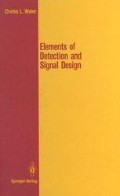Abstract
Thus far we have considered only binary decision problems, that is, models where the decision space consists of two elements. In such problems the signal space either consisted of two elements or was partitioned into two disjoint subspaces. Let us now develop the more general situation in which the signal set consists of M possible signals or M classes of signals with a priori probabilities π;i = 1, …, M. Such a model arises in certain communication systems and in pattern-recognition problems. For example, in communications, instead of recognizing or detecting a binary sequence bit by bit, as we have done previously, we might delay the decision until a sequence of length n has been observed, at which point the receiver attempts to decide which signal has been transmitted from a class of M = 2n possibilities, that is the class of possible sequences of binary bits of length n. This is known as block encoding.
Access this chapter
Tax calculation will be finalised at checkout
Purchases are for personal use only
Preview
Unable to display preview. Download preview PDF.
References
Middleton, D.: “Introduction to Statistical Communication Theory,” McGrawHill, New York, 1960.
Viterbi, A. J.: “Principles of Coherent Communications,” McGraw-Hill, New York, 1966.
Wozencraft, J. M., and I. M. Jacobs: “Principles of Communication Engineering,” Wiley, New York, 1965.
Hancock, J. C., and P. A. Wintz: “Signal Detection Theory,” Moflraw-Hill, New York, 1966.
Golomb, S., et al.: “Digital Communications,” Prentice-Hall, Englewood Cliffs, N.J., 1964.
Arthurs, E., and H. Dym: On the Optimum Detection of Digital Signals in the Presence of White Gaussian Noise: A Geometric Interpretation and a Study of Three Basic Data Transmission Systems, IRE Trans. Commun. Systems, vol. CS-I0, December, 1962.
Nuttall, A.: Error Probabilities for Equi Correlated M-ary Signals under Phase Coherent and Phase Incoherent Reception, IRE Trans. Inform. Theory, vol. IT-8, July, 1962.
Turin, G. L.: An Introduction to Matched Filters, IRE Trans. Inform. Theory, vol. IT-6, June, 1960.
Price, R.: Optimum Detection of Random Signals in Noise, with Applications to Scatter-multipath Communication, IRE Trans. Inform. Theory, vol. IT-2, 1956.
Helstrom, C. W.: The Resolution of Signals in White Gaussian Noise, Proc. IRE, vol. 43, September, 1955.
Bussgang, J. J., and M. Leiter: Error Rate Approximation for Differential Phase Shift Keying, IEEE Trans. Commun. Systems, vol. CS-12, pp. 18–27, March, 1964.
Bussgang, J. J., and M. Leiter: Phase Shift Keying with a Transmitted Reference, IEEE Trans. Commun. Technol., vol. Com-14, no. 1, pp. 14–22, February, 1966.
Author information
Authors and Affiliations
Rights and permissions
Copyright information
© 1987 Springer-Verlag New York Inc.
About this chapter
Cite this chapter
Weber, C.L. (1987). M-ary Digital Communication Systems. In: Elements of Detection and Signal Design. Springer Texts in Electrical Engineering. Springer, New York, NY. https://doi.org/10.1007/978-1-4612-4774-6_10
Download citation
DOI: https://doi.org/10.1007/978-1-4612-4774-6_10
Publisher Name: Springer, New York, NY
Print ISBN: 978-1-4612-9150-3
Online ISBN: 978-1-4612-4774-6
eBook Packages: Springer Book Archive

